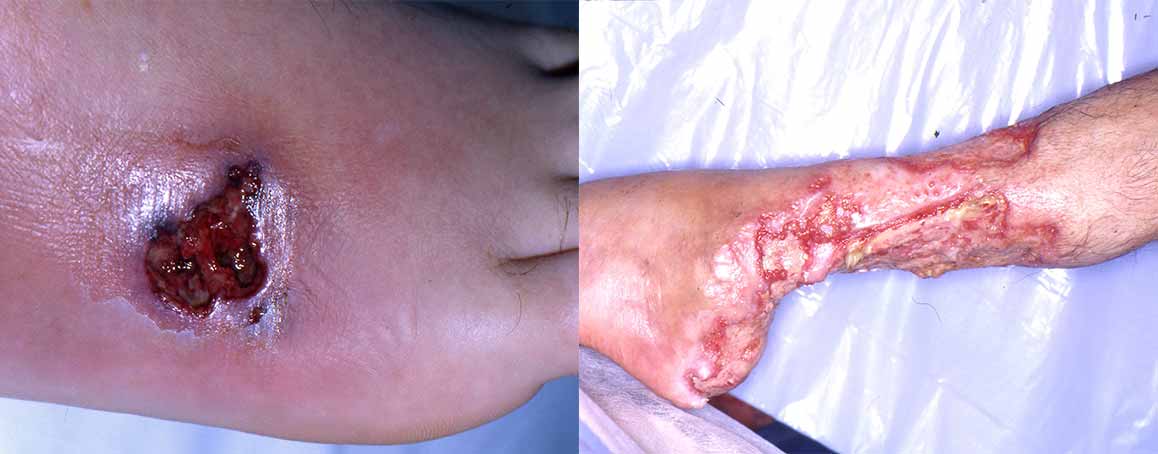Leg ulcers
What are leg ulcers?
Leg ulcers are extremely common and occur more frequently in elderly people. In countries with developed health systems, 1-3% of the total health budget is spent on treating leg ulcers.
An ulcer is a defect in the skin or mucous membranes, similar to a wound. While wounds can be superficial or deep, ulcers by definition are always deep. When ulcers heal, they usually leave a scar. By contrast, erosion refers to a more superficial wound which heals without leaving a scar.

What causes leg ulcers?
There are multiple causes of leg ulceration. The most common cause is venous disease. Other causes include:
- Chronic varicose veins
- Arterial ulcers and peripheral vascular disease
- Neuropathic ulcers such as those associated with diabetes
- Skin conditions such as vasculitis and pyoderma gangrenosum
- Tumours
- Trauma
- Infections
- Other less common causes

Venous ulcers and varicose veins
Venous ulcers are the most common chronic wounds in humans.
Venous ulcers are caused by venous hypertension (high blood pressure in the leg veins). Chronic varicose veins or a previous deep vein thrombosis can result in venous hypertension.
Venous ulcers are usually accompanied by other clinical signs of venous disease such as swelling, pigmentation, varicose dermatitis, atrophie blanche and lipodermatosclerosis. High blood pressure in the leg veins causes leakage of fluid from the abnormal veins into the surrounding tissues. This leads to swelling, especially around the ankles. Leakage of red blood cells leads to iron staining and skin pigmentation in the lower legs. The subsequent inflammation will result in varicose eczema and may lead to scarring (known as atrophie blanche) and hardening of the skin and fat (known as lipodermatosclerosis) in affected areas. This will eventually lead to skin breakdown and ulceration.
Dressings have a limited role in the management of venous ulcers and compression is needed to control the underlying venous hypertension.
If the underlying veins need to be treated, the ideal treatment in elderly people involves non-invasive techniques such as endovenous laser ablation (EVLA) and foam sclerotherapy to achieve long-term healing. Surgery may be necessary in selected cases. Leg elevation, compression stockings and occasional, intermittent pneumatic compression pumps should be used to prevent recurrence.
Arterial ulcers and peripheral vascular disease
Arterial ulcers are less common than venous ulcers. They are more common in men, smokers and people with diabetes. In some people, leg ulcers may be related to both arterial and venous diseases being present at the same time.
These ulcers are caused by lack of normal blood flow to the tissues. Leg arteries that carry blood to the tissues are partially or completely blocked. Risk factors include atherosclerosis (the same process that leads to heart attacks and strokes), high blood pressure, smoking and diabetes.
Blocked arteries need to be re-opened or by-passed whenever possible to allow enough blood to reach the target tissues. Angioplasty or bypass operations may be required to re-constitute the blood flow. Compression in such cases may be counterproductive.
Neuropathic ulcers
People with diabetes develop peripheral neuropathy. This results in a loss of sensation in a “glove and sock” distribution. Affected individuals may not be aware of trauma to the foot and develop ulcers in the traumatised areas.
Other causes
There are other causes of leg ulcers such as skin conditions (eg. pyoderma gangrenosum), infections and malignant tumours. A biopsy may be needed to identify the exact cause so that it can be treated appropriately.
How are leg ulcers managed?
The most important first step in the management of leg ulcers is making the correct diagnosis. Ulcers can be caused by a range of conditions which each require very different treatment strategies.
Photographs and measurements of the ulcer’s size and depth should be taken over time to monitor progress. Blood tests may be necessary to investigate associated conditions such as diabetes. Skin biopsies may be needed to exclude rare causes such as tumours, vasculitis and infections. Ulcers may need to be swabbed from time to time and infections treated appropriately. Ultrasound studies are required to establish the status of the underlying venous and arterial systems and plan treatment. X-rays, MRI and other imaging investigations may be required to exclude unusual underlying causes or associated problems such as osteomyelitis.
It is important to consult health professionals who are skilled in managing leg ulcers. Wet and moist ulcers require daily change of dressings whereas dry ulcers require moist dressings. Excessive moisture will impede the healing of most ulcers. Different types of dressings may be needed depending on the status of the ulcer (wet/dry/infected). Compression is very important in the management of venous ulcers but may need to be avoided in arterial ulcers.
The underlying condition should be identified and treated. With venous ulcers, the underlying veins should be treated. With conditions such as pyoderma gangrenosum, the ulcer responds to appropriate treatment of the underlying inflammatory bowel disease. Referrals to specialist centres will be required when dealing with non-healing recalcitrant ulcers.
This information has been written Clinical Associate Professor Dr Kurt Gebauer
Updated 4 August 2015